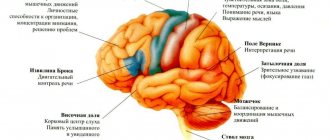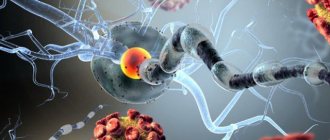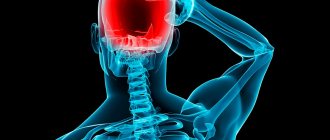Stages of disease development
The pathogenesis of a brain abscess involves four stages of its development:
- Early brain inflammation (1-3 days). The patient develops encephalitis, a limited inflammation of brain tissue. The important thing is that at this stage it is still quite possible to reverse the disease. The inflammatory process can end spontaneously or upon completion of antibacterial therapy.
- Late stage (4-9 days). This stage occurs when the protective functions of the patient’s body are weakened or due to incorrectly chosen treatment tactics. Therefore, the inflammation begins to progress - the cavity filled with pus begins to increase in size.
- Early encapsulation (10-13 days). This stage of inflammation is characterized by necrosis of the central part of the brain, as well as the formation of a capsule that limits the further spread of pus.
- Late encapsulation (starting from day 14). Starting from the second week after activation of the inflammatory process, the patient is diagnosed with a clear collagen capsule filled with pus and surrounded by a zone of gliosis. The further development of inflammation depends on the reactivity of the patient’s body, the virulence of the flora, and proper treatment. Often at this stage there is an increase in the volume of purulent content and the formation of new foci of inflammation.
Clinical researches
Clinical studies have proven that regular use of professional toothpaste ASEPTA REMINERALIZATION improved the condition of the enamel by 64% and reduced tooth sensitivity by 66% after just 4 weeks.
Sources:
- Report on the determination/confirmation of the preventive properties of personal oral hygiene products “ASEPTA PLUS” Remineralization doctor-researcher A.A. Leontyev, head Department of Preventive Dentistry, Doctor of Medical Sciences, Professor S.B. Ulitovsky First St. Petersburg State Medical University named after. acad. I.P. Pavlova, Department of Preventive Dentistry
- Clinical and laboratory assessment of the influence of domestic therapeutic and prophylactic toothpaste based on plant extracts on the condition of the oral cavity in patients with simple marginal gingivitis. Doctor of Medical Sciences, Professor Elovikova T.M.1, Candidate of Chemical Sciences, Associate Professor Ermishina E.Yu. 2, Doctor of Technical Sciences Associate Professor Belokonova N.A. 2 Department of Therapeutic Dentistry USMU1, Department of General Chemistry USMU2
- Clinical experience in using the Asepta series of products Fuchs Elena Ivanovna Assistant of the Department of Therapeutic and Pediatric Dentistry State Budgetary Educational Institution of Higher Professional Education Ryazan State Medical University named after Academician I.P. Pavlova of the Ministry of Health and Social Development of the Russian Federation (GBOU VPO RyazSMU Ministry of Health and Social Development of Russia)
General cerebral symptoms
General cerebral symptoms arise due to sudden jumps in intracranial pressure. The most common symptom of the pathology is headache accompanied by vomiting. The patient may experience problems with vision: often, against the background of an abscess, optic neuritis develops, and congestive discs appear in the fundus. The clinical picture of the disease also includes mental disorders, inhibition of thought processes, lethargy, weakness, and apathy. In the case of intracranial hypertension, epileptic seizures may occur. Most patients also experience persistent drowsiness, and in the most severe cases, coma may occur.
Course of a brain abscess
As for the course of the disease, it often has a very violent and acute onset, which is characterized by focal and hypertensive manifestations. The inflammatory process almost always develops against a background of elevated temperature. In rare cases, the onset of the disease may be less pronounced and resemble the clinical picture of meningitis. However, with minimal symptoms and normal temperature, the first stage of the disease is extremely rare.
After 5-30 days, the disease passes into the next, latent, stage, which is characterized by either a complete absence of any symptoms, or minimally expressed signs of the disease. The patient may complain of severe and regular headaches, mental retardation and vomiting. The duration of this stage varies: in some patients it lasts a couple of days, while in others it lasts several years. Then, due to the influence of some factor (for example, infection), this stage ends and the patient’s symptoms begin to actively progress. The most severe and life-threatening consequence of a brain abscess is its rupture, which usually leads to death.
Meningoencephalitis: classification
Today, neurologists divide meningoencephalitis into various types according to several criteria: etiology, nature of morphological changes and type of course. Based on etiology, the following types of encephalitis are distinguished:
- Viral - pathogens can be influenza viruses, herpes simplex, measles, rabies, cytomegalovirus, enteroviruses. The serous nature of inflammatory changes predominates;
- Bacterial - pathogens can be strepto-, meningo-, pneumococci, Klebsiella, Haemophilus influenzae. The inflammation has a purulent nature of inflammatory changes;
- Protozoan - extremely rare. Infectious agents are amoebas, toxoplasma and other protozoa;
- Fungal – mainly observed in immunocompromised individuals. Can be diagnosed as part of neuroAIDS.
Diagnosis of brain abscess
Timely comprehensive diagnosis of brain abscess is important in its further treatment. To make a diagnosis, a neurologist uses medical history and examination results of the patient, as well as information obtained during instrumental and laboratory tests. The following methods are used to diagnose the disease:
- General blood analysis. The disease is usually indicated by test results such as an increase in ESR and pronounced leukocytosis. At the stage of capsule formation around the abscess, a normal or slightly increased number of leukocytes is observed in the patient’s blood.
- CT scan. The accuracy of detecting an abscess using this technique depends on the stage of the pathology. In the early stages, an abscess is very difficult to detect. At the stage of encephalitis, CT may reveal an area of reduced density that has an uneven shape. At this stage, the contrast agent accumulates unevenly - often only in the peripheral areas. It is much more accurate to diagnose the disease at a late stage in the development of encephalitis.
- Magnetic resonance imaging. This is a more accurate and effective method of diagnosing an abscess, which allows it to be detected at an early stage. Since the technique is considered the most informative, treatment can be prescribed based on its results even without bacteriological tests.
- Echoencephaloscopy. This diagnostic method is usually prescribed if for some reason MRI and CT cannot be performed. Using this study, it is possible to detect displacement of brain structures, which indicates compression of its tissues by an abscess.
- Bacteriological research. This technique involves taking a puncture of pus from the abscess for examination. A detailed examination of the pus helps to identify the causative agent of inflammation, which then makes it possible to select the most appropriate tactics of drug therapy.
- X-ray of the skull. This technique is used to detect the source of infection that caused the abscess.
- Craniography. Prescribed to detect symptoms of intracranial hypertension.
Differential diagnosis of brain abscess
Since the majority of symptoms of brain abscess are not specific, differential diagnosis plays an important role. If the doctor has doubts during diagnosis, he may prescribe MR spectroscopy. This technique is carried out in order to differentiate a brain abscess from tumors of the cerebral hemispheres. It is based on different contents of lactate and amino acids in tumors and purulent accumulations.
As for other diagnostic methods, they are considered less informative. For example, signs such as an increase in C-reactive protein in the blood, chills, an increase in ESR, and leukocytosis may indicate a variety of inflammatory processes. Blood cultures from an abscess are often sterile.
Treatment of brain abscess
Treatment for a brain abscess usually involves both drug therapy and surgery. Doctors select the most optimal treatment tactics based on the results of diagnosing the disease, as well as the general health of the patient. The stage of the disease is also taken into account. For example, in the early stages of abscess formation, conservative treatment can be used. If an abscess has already formed, and a dense capsule has formed around it, neurosurgical intervention cannot be avoided.
- Drug treatment
- Surgery
Drug treatment of brain abscess involves the prescription of antibiotics, decongestants and anticonvulsants. Since the inflammatory process is provoked by bacteria, treatment of the disease necessarily involves their destruction. The combination of penicillin and chloramphenicol has been considered the most standard and commonly used treatment regimen for brain abscess for decades.
Penicillin was prescribed to treat the disease because it can kill streptococci and most other bacteria that can cause brain abscess. Chloramphenicol was used because of its ability to easily dissolve in adipose tissue and destroy anaerobic bacteria.
Today doctors are slightly adjusting this scheme. For example, cefotaxime is prescribed instead of penicillin, and metronidazole is prescribed instead of chloramphenicol. Typically, the doctor prescribes antibiotic therapy several weeks before surgery. The duration of taking antibiotics can be about 6-8 weeks.
Patients whose brain abscess occurs due to immunodeficiency are also prescribed amphoreticin. If the abscess has resolved, the patient will need to take a course of fluconazole for ten weeks. Drugs such as sulfadiazine and pyrimethamine are commonly included in the treatment regimen of patients with HIV.
Of great importance in the treatment of the disease is the correct identification of the causative agent of infection using an antibiogram. However, there are cases when the culture turns out to be completely sterile. Therefore, in such situations, empirical antibiotic therapy is prescribed.
In addition to antibiotics, medications are also prescribed to help reduce swelling. For example, glucocorticoids are used for this purpose. However, the prescription of these drugs is indicated only in case of a positive result from antibacterial therapy. They can reduce the severity of a brain abscess and reverse the development of the capsule around it. However, the opposite effect is also possible, when glucocorticoids activate the spread of inflammation beyond the boundaries of the lesion. To eliminate convulsive manifestations, phenytoin is usually prescribed.
If a brain abscess is diagnosed in the late stages, and a dense capsule has already formed around it, it is impossible to do without surgery. To treat the disease, puncture aspiration and removal of the abscess are most often used.
As for puncture aspiration, it is advisable to prescribe it in the early stages of the pathology. In this case, antibacterial therapy should be carried out simultaneously. Indications for this procedure may also include multiple abscesses, a deep location of the abscess, the stage of cerebritis and a stable neurological condition of the patient. To ensure that the procedure is performed as accurately as possible, the doctor resorts to stereotactic biopsy and intraoperative ultrasound.
Needle aspiration has one important drawback - in most cases, a repeat procedure may be required after it is performed. In difficult cases, complete removal of the abscess is prescribed. This technique is also prescribed if they want to avoid a possible relapse of the disease. It is advisable to remove an abscess for the following indications: if antibacterial therapy or puncture aspiration are not effective, with a superficial abscess and a well-formed capsule around it.
If multiple abscesses were discovered in a patient during diagnosis, then first you need to drain the inflammation to prevent pus from breaking into the ventricular system of the brain. If neurological disorders increase or there is no positive dynamics on MRI and CT, a repeat operation may be prescribed.
BACTERIAL MENINGITIS
Bacterial meningitis
- inflammation of the meninges, acute or chronic, manifested by characteristic clinical symptoms and pleocytosis of the CSF.
ACUTE BACTERIAL MENINGITIS
Main pathogens
The incidence of bacterial meningitis averages about 3 cases per 100 thousand population. In more than 80% of cases, bacterial meningitis is caused by N.meningitidis, S.pneumoniae
and
H. influenzae.
In Russia N.meningitidis
is the cause of about 60% of cases of bacterial meningitis,
S. pneumoniae
- 30% and
H. influenzae
- 10%.
It should be noted that in developed countries, after the introduction of large-scale vaccination against H. influenzae
type B, the incidence of bacterial meningitis of this etiology decreased by more than 90%.
In addition, bacterial meningitis can be caused by other microorganisms (listeria, group B streptococci, enterobacteria, S. aureus
, and etc.).
The causative agents of bacterial meningitis can be spirochetes: with Lyme disease, 10-15% of patients have meningeal syndrome in the first 2 weeks after infection. In general, the etiology is largely determined by the age and premorbid background of the patients (Table 2).
Table 1. Dependence of the etiology of bacterial meningitis on the age of patients and premorbid background
| 0-4 weeks | S.agalactiae, E.coli, L.monocytogenes, K. pneumoniae, Enterococcus spp., Salmonella spp. |
| 4-12 weeks | E.coli, L.monocytogenes, H.influenzae, S.pneumoniae, N.meningitidis |
| 3 months-5 years | H.influenzae, S.pneumoniae, N.meningitidis |
| 5-50 years | S. pneumoniae, N. meningitidis |
| >50 years | S.pneumoniae, N.meningitidis, L.monocytogenes, Enterobacteriaceae |
| Immunosuppression | S.pneumoniae, N.meningitidis, L.monocytogenes, Enterobacteriaceae, P.aeruginosa |
| Fracture of the base of the skull | S. pneumoniae, H. influenzae, S. pyogenes |
| Head trauma, neurosurgery and craniotomy | S.aureus, S.epidermidis, Enterobacteriaceae, P.aeruginosa |
| Cerebrospinal bypass | S.epidermidis, S.aureus, Enterobacteriaceae, P.aeruginosa, P.acnes |
| Sepsis | S.aureus, Enterocococcus spp., Enterobacteriaceae, P.aeruginosa, S.pneumoniae |
Bacterial meningitis can occur in a hospital after neurosurgical or otorhinolaryngological operations, in which case gram-negative (up to 40%) and gram-positive flora (up to 30%) play an important role in the etiology. Nosocomial flora, as a rule, is characterized by high resistance and mortality with this etiology reaches 23-28%.
Choice of antimicrobials
Success of treatment of acute bacterial meningitis
depends on a number of factors and, first of all, on the timeliness and correctness of the administration of antimicrobial agents. When choosing antibiotics, you need to remember that not all of them penetrate the BBB well (Table 2).
Table 2. Passage of antimicrobial drugs through the BBB
| Fine | Good only for inflammation | Bad even with inflammation | They don't pass |
| Isoniazid | Aztreons | Gentamicin | Clindamycin |
| Co-trimoxazole | Azlocillin | Carbenicillin | Lincomycin |
| Pefloxacin | Amikacin | Lomefloxacin | |
| Rifampicin | Amoxicillin | Macrolides | |
| Chloramphenicol | Ampicillin | Norfloxacin | |
| Vancomycin | Streptomycin | ||
| Meropenem | |||
| Ofloxacin | |||
| Benzylpenicillin | |||
| III-IV generation cephalosporins | |||
| Cefuroxime | |||
| Ciprofloxacin |
With the exception of cefoperazone.
Antimicrobial therapy should be started immediately after a preliminary diagnosis is made. It is important that lumbar puncture and collection of material (CSF, blood) for microbiological examination are performed before antibiotics are administered.
The choice of AMP is based on the results of the examination, including preliminary identification of the pathogen after Gram staining of CSF smears and serological rapid tests.
If rapid diagnostic methods do not allow preliminary identification of the pathogen, or for some reason there is a delay in performing a lumbar puncture, then antibacterial therapy is prescribed empirically. The choice of AMPs in this situation is dictated by the need to cover the entire spectrum of the most likely pathogens (Table 3).
Table 3. Empirical antimicrobial therapy for bacterial meningitis
| Predisposing factor | A drug |
| Age | |
| 0-4 weeks | Ampicillin + cefotaxime, ampicillin + gentamicin |
| 4-12 weeks | Ampicillin + cefotaxime or ceftriaxone |
| 3 months-5 years | Cefotaxime or ceftriaxone + ampicillin + chloramphenicol |
| 5-50 years | Cefotaxime or ceftriaxone (+ ampicillin if listeria is suspected), benzylpenicillin, chloramphenicol |
| Over 50 years old | Ampicillin + cefotaxime or ceftriaxone |
| Immunosuppression | Vancomycin + ampicillin + ceftazidime |
| Fracture of the base of the skull | Cefotaxime or ceftriaxone |
| Head injuries, conditions after neurosurgical operations | Oxacillin + ceftazidime, vancomycin + ceftazidime |
| Cerebrospinal bypass | Oxacillin + ceftazidime, vancomycin + ceftazidime |
Antimicrobial therapy may be modified when the pathogen is isolated and susceptibility results are obtained (Table 4).
Table 4. Antimicrobial therapy for bacterial meningitis of established etiology
| Pathogen | Drugs of choice | Alternative drugs |
| H.influenzae β-lactamase (-) β-lactamase (+) | Ampicillin Cefotaxime or ceftriaxone | Cefotaxime, ceftriaxone, cefepime, chloramphenicol Cefepime, chloramphenicol, aztreonam, fluoroquinolones |
| N.meningitidis penicillin MIC < 0.1 mg/l penicillin MIC 0.1-1.0 mg/l | Benzylpenicillin or ampicillin Cefotaxime or ceftriaxone | Cefotaxime, ceftriaxone, chloramphenicol Chloramphenicol, fluoroquinolones |
| S. pneumoniae Penicillin MIC < 0.1 mg/l Penicillin MIC 0.1-1.0 mg/l Penicillin MIC > 2.0 mg/l | Benzylpenicillin or ampicillin Cefotaxime or ceftriaxone Vancomycin + cefotaxime or ceftriaxone (+ rifampicin) | Cefotaxime, ceftriaxone, chloramphenicol, vancomycin Meropenem, vancomycin (+ rifampicin) Meropenem |
| Enterobacteriaceae | Cefotaxime or ceftriaxone | Aztreonam, fluoroquinolones, co-trimoxazole, meropenem |
| P. aeruginosa | Ceftazidime (+ amikacin) | Meropenem, ciprofloxacin, aztreonam (+ aminoglycosides) |
| L.monocytogenes | Ampicillin or benzylpenicillin (+ gentamicin) | Co-trimoxazole |
| S.galactiae | Ampicillin or benzylpenicillin (+ aminoglycosides) | Cefotaxime, ceftriaxone, vancomycin |
| S. aureus MSSA MRSA | Oxacillin Vancomycin | Vancomycin Rifampicin, co-trimoxazole |
| S. epidermidis | Vancomycin (+ rifampicin) | |
| Spirochetes T.pallidum B.burgdorferi | Benzylpenicillin Ceftriaxone or cefotaxime | Ceftriaxone, doxycycline Benzylpenicillin, doxycycline |
Maximum doses of antibiotics are used during treatment
, which is especially important when using AMPs that poorly penetrate the BBB, so it is necessary to strictly adhere to the accepted recommendations (Table 5). Particular attention is required when prescribing antibiotics to children (Table 6).
Table 5. Doses of antimicrobial drugs for the treatment of CNS infections in adults
| A drug | Daily dose, i.v. | Intervals between injections, h |
| Aztreons | 6-8 g | 6-8 |
| Amikacin | 15-20 mg/kg | 12 |
| Ampicillin | 12 g | 4 |
| Benzylpenicillin | 18-24 million units | 4 |
| Vancomycin | 2 g | 6-12 |
| Gentamicin | 5 mg/kg | 8 |
| Co-trimoxazole | 10-20 mg/kg (for trimethoprim) | 6-12 |
| Meropenem | 6 g | 8 |
| Metronidazole | 1.5-2 g | 8 |
| Oxacillin | 9-12 g | 4 |
| Rifampicin | 0.6 g | 24 |
| Tobramycin | 5 mg/kg | 8 |
| Chloramphenicol | 4 g | 6 |
| Cefotaxime | 12 g | 6 |
| Ceftazidime | 6 g | 8 |
| Ceftriaxone | 4 g | 12-24 |
| Ciprofloxacin | 1.2 g | 12 |
Table 6. Doses of antimicrobial drugs for the treatment of acute bacterial meningitis in children*
| A drug | Daily dose (interval between administrations, h) | ||
| Newborns (0-7 days) | Newborns (8-28 days) | Children | |
| Amikacin | 15-20 mg/kg (12) | 20-30 mg/kg (8) | 20-30 mg/kg (8) |
| Ampicillin | 100-150 mg/kg (8-12) | 150-200 mg/kg (6-8) | 200-300 mg/kg (6) |
| Benzylpenicillin | 100-150 thousand units/kg (8-12) | 200 thousand units/kg (6-8) | 250-300 thousand units/kg (4-6) |
| Vancomycin | 20 mg/kg (12) | 30-40 mg/kg (8) | 50-60 mg/kg (6) |
| Gentamicin | 5 mg/kg (12) | 7.5 mg/kg (8) | 7.5 mg/kg (8) |
| Co-trimoxazole | 10-20 mg/kg (6-12) | ||
| Tobramycin | 5 mg/kg (12) | 7.5 mg/kg (8) | 7.5 mg/kg (8) |
| Chloramphenicol | 25 mg/kg (24) | 50 mg/kg (12-24) | 75-100 mg/kg (6) |
| Cefepime | 50 mg/kg (8) | ||
| Cefotaxime | 100 mg/kg (12) | 150-200 mg/kg (6-8) | 100 mg/kg (6-8) |
| Ceftazidime | 60 mg/kg (12) | 90 mg/kg (8) | 125-150 mg/kg (8) |
| Ceftriaxone | 80-100 mg/kg (12-24) | ||
A. R. Tunkel, W. M. Scheld. Acute meningitis. In: Principles and practice of infectious diseases, 5th Edition. Edited by: G. L. Mandell, J. E. Bennett, R. Dolin. Churchill Livingstone
, 2000; p. 980
The main route of administration of AMPs is intravenous. According to indications (secondary bacterial meningitis against the background of sepsis, especially polymicrobial sepsis, purulent complications of traumatic brain injuries and operations, etc.), intravenous and endolumbar administration can be combined (Table 7). Only AMPs that poorly penetrate the CSF (aminoglycosides, vancomycin) are administered endolumbarally. The drugs can be used in the form of mono- or combination therapy. The indication for changing AMPs is the absence of positive clinical and laboratory dynamics of the patient’s condition or the appearance of signs of an undesirable effect of the drug.
Table 7. Doses of antimicrobial drugs for endolumbar administration
| A drug | Dose |
| Gentamicin | 4-8 mg 1 time per day |
| Tobramycin | 4-8 mg 1 time per day |
| Amikacin | 4-20 mg 1 time per day |
| Vancomycin | 4-10 mg 1 time per day |
In addition to compliance with single and daily doses of antimicrobial agents, the duration of their administration is important for bacterial meningitis.
To treat meningitis caused by spirochetes, drugs with the appropriate spectrum of activity are used (Table 4).
MENINGITIS AS A SYNDROME OF A CHRONIC INFECTIOUS PROCESS
In a number of infections characterized by a chronic course, the process may spread to the membranes of the brain. In this case, meningeal syndrome may occur and the composition of the CSF changes.
From the point of view of complications of chronic infections, tuberculous meningitis poses the greatest danger. Delayed treatment of this meningitis often leads to an unfavorable outcome. The emergence of PCR-based diagnostic systems has significantly reduced the duration of examination and significantly increased the effectiveness of treatment.
Damage to the meninges can also be observed in other infections: brucellosis, cysticercosis, syphilis, borreliosis, coccidioidosis, histoplasmosis, cryptococcosis, etc.
Choice of antimicrobials
Treatment of this meningitis is determined by the underlying disease. Very often, it seems almost impossible to find out the etiology of the process. In this case, along with continuing the search for the pathogen, the so-called trial empirical treatment is used. For example, if tuberculous meningitis is suspected, anti-tuberculosis drugs are prescribed and, when clinical improvement occurs, the course of therapy is completed. If candidiasis is suspected, a trial treatment with fluconazole is used.
Prognosis for brain abscess
The outcome of the disease depends on whether the doctor was able to identify the causative agent of the abscess from culture. It is extremely important to do this, since then it will be possible to determine the sensitivity of bacteria to antibiotics and select the most appropriate treatment regimen. The prognosis for the health of a patient with a brain abscess also depends on the number of purulent accumulations, the patient’s health status, and the correct treatment tactics.
The risk of various complications with a brain abscess is very high. Namely, about 10% of all cases of the disease end in death, and 50% result in disability. In addition, most patients may develop epileptic syndrome after treatment, a condition characterized by the occurrence of epileptic seizures.
Doctors give less favorable prognoses to patients who have been diagnosed with subdural empyema. In this case, the patient does not have a clear boundary of the purulent focus due to the high activity of the infectious agent or the body’s insufficient resistance to it. Lethal cases with subdural empyema reach 50%.
The most dangerous form of brain abscess is considered to be fungal empyema, which is accompanied by immunodeficiency. This disease has practically no cure, and the number of deaths with it is about 95%. In turn, epidural empyemas have a more favorable prognosis and are almost never accompanied by complications.
Prevention of brain abscess
There are no effective methods for preventing brain abscess. However, with the help of several preventive measures, the risk of the disease can be significantly reduced. In particular, in the case of traumatic brain injury, the patient must receive adequate surgical care.
The disease can also be prevented by timely elimination of foci of infection (pneumonia, boils), treatment of purulent processes in the inner and middle ear, as well as the paranasal sinuses. Good nutrition also plays a great role in the prevention of brain abscess.
Risk factors
Risk factors for hematogenous spread include [4]:
- right-to-left shunting congenital heart defects
- pulmonary AVMs or AV fistulas as manifestations of hereditary hemorrhagic telangiectasia
- intravenous drug administration
- lung abscesses









